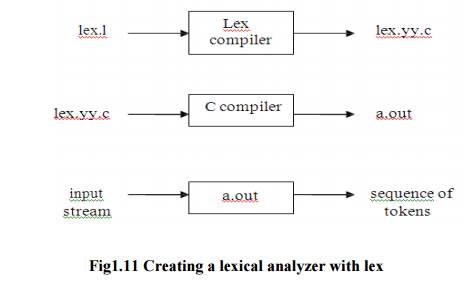Chapter: Principles of Compiler Design : Lexical Analysis
A Language For Specifying Lexical Analyzer
A LANGUAGE FOR SPECIFYING LEXICAL
ANALYZER
There is a wide range of tools for constructing
lexical analyzers.
Lex
YACC
Lex is a computer
program that generates lexical analyzers. Lex is commonly used with the yacc
parser generator.
Creating a lexical analyzer
•
First, a specification of a lexical
analyzer is prepared by creating a program lex.l in the Lex language. Then,
lex.l is run through the Lex compiler to produce a C program lex.yy.c.
•
Finally, lex.yy.c is run through the C
compiler to produce an object progra m a.out, which is the lexical analyzer
that transforms an input stream into a sequence of tokens.

Fig1.11
Creating a lexical analyzer with lex
Lex Specification
A Lex program consists of three parts:
{ definitions }
%%
{ rules }
%%
{ user subroutines }
Definitions include
declarations of variables, constants, and regular definitions
Ø
Rules are
statements of the form
p1
{action1}
p2
{action2}
…
pn
{actionn}
where pi is regular expression and actioni
describes what action the lexical analyzer should take
when pattern pi matches a lexeme. Actions
are written in C code.
User subroutinesare
auxiliary procedures needed by the actions. These can be compiledseparately
and loaded with the lexical analyzer.
YACC- YET ANOTHER COMPILER-COMPILER
Yacc provides a general
tool for describing the input to a computer program. The Yacc user specifies
the structures of his input, together with code to be invoked as each such
structure is recognized.
Yacc turns such a
specification into a subroutine that handles the input process; frequently, it
is convenient and appropriate to have most of the flow of control in the user's
application handled by this subroutine.
Finite Automata
Finite Automata is one
of the mathematical models that consist of a number of states and edges. It is
a transition diagram that recognizes a regular expression or grammar.
There are tow types of Finite Automata :
·
Non-deterministic Finite Automata (NFA)
·
Deterministic Finite Automata (DFA)

Deterministic Finite Automata
DFA is a special case of a NFA in which i) no state
has an ε-transition.
ii)
there is at most one transition from
each state on any input.
DFA has five tuples denoted by
M = {Qd, Ʃ, δ, q0, fd}
Qd – finite set of states
Ʃ
– finite set of input symbols

Construction of DFA from regular
expression
The following steps are involved in the construction
of DFA from regular expression:
Convert RE to NFA using Thomson’s rules
Convert NFA to DFA
Construct minimized DFA
Related Topics